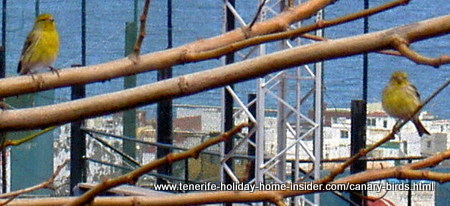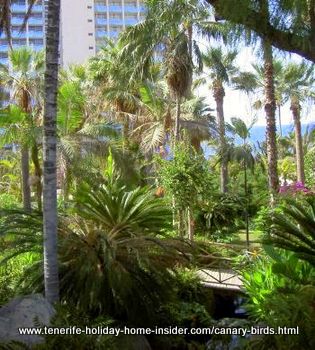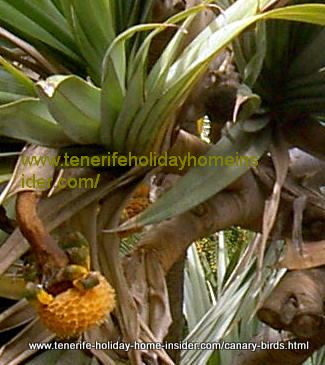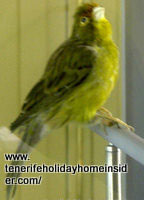Canary birds photo with information about their Tenerife wildlife
Indeed, Canary Birds of the singing Finch species Serinus Canariae are not extinct in the open in Tenerife, is
what I thought when a friend and I spotted a pair of them, a few years ago. Could that have changed?
Strangely enough, they didn't seem to mind the traffic by the busy roadside. There, they were flying from one bare branch to another where their happy chirping had given them away.
Of course, they were also enjoying the beautiful, warm day. Most creatures need full sun for Vitamin D during at least some part of the day to remain healthy, you know...
What made sense is that they seemed to have come from the huge park of Hotel Maritim now called Hotel Precise Resort of Los Realejos.
This is also right opposite the 'Beisbol' stadium of Puerto de la Cruz.
Why were the nearby lush subtropical gardens certainly their habitat?
Parks that are frequently watered provide water. Their many trees and palms offer shelter and many seeds to feed on. There are also ponds for the birds to bath.
Then of course, more wild Canary Birds are roosting nearby. That's important during the breeding season that is close to the Solstice at Fiesta San Juan.
By the way, you may even spot a fig tree on the border of the Maritim tourist resort. Figs have Vitamin C and are most rich in Calcium, above all. Hence, the Canary songbirds love them very much.
Want to hear one of Canary Birds sing?
The above video gives good testimony of the Canary' bird's vocal talent, indeed. This may be a hybrid, though.
What do the typical singing Finches of the type look like?
They are not more than 10 cm or 3,9 inches big. That's the size with tails.
Their beaks are slightly curbed but broad, contrary to those of birds of prey. They have bright yellow bellies and faces as well as brownish backs contrary to the hybrid Canaries. Brown offers good camouflage in the wild that's less visible to Hawks and Eagles from above. However, I haven't seen any in this coastal region by the busy 'El Burgado' road.
Another spot in town with Island Canaries
I have been on the look-out for them in the trees of the park of the former bus station in Puerto de la Cruz. This town is also much known for its bird and animal embassy. None seem to be there any more. Would it be lack of water, food and lack of clean air that made them perhaps look for better grounds?
Any danger for the top Canary singing Finch to disappear?
I have spotted wild Canary Birds at La Caldera in the past but not, when I went there last in 2024. The same applies to the forests around Cruz del Carmen where other birds seem to concentrate now by the main restaurant. Hopefully, the top Canary singing Finches won't do alike becoming crumb feeders. Or is it lack of rain water lately that makes them leave certain areas?
By the way, I have not yet seen any Canary Mountain bird called the Pajaro Canario del Monte in Spanish. Find out if the same as well as Tenerife birds of Masca are threatened by extinction clicking here ... Rats and cats, by the way, could not do so by eradicating them totally. They have been natural enemies for thousands of years, you know...
An Atlantic Canary in a Santa Cruz museum
That's a stuffed specimen of the wild Canary yellow bird. It's also named the Island Canary at one of Tenerife museums in Santa Cruz capital called 'Museo del Hombre y de la Naturaleza' which means Museum of Man and Nature.
From Canary birds back to wildlife Tenerife of the Canary Islands Spain

Please mind that the comment box below is meant to help others. In case you have a question or want to tell me something, kindly use this contact form.
This site is protected by Copyscape
Transfer wanted
in Europe?

Optica Columbus Best optician Tenerife North Important eye tests Call 922 387072
Insider

Note:
Text and images within this site are not to be copied or traded at any time. This regards online and offline.
Please respect my copyright






New! Comments
Have your say about what you just read! Leave me a new comment in the box below.